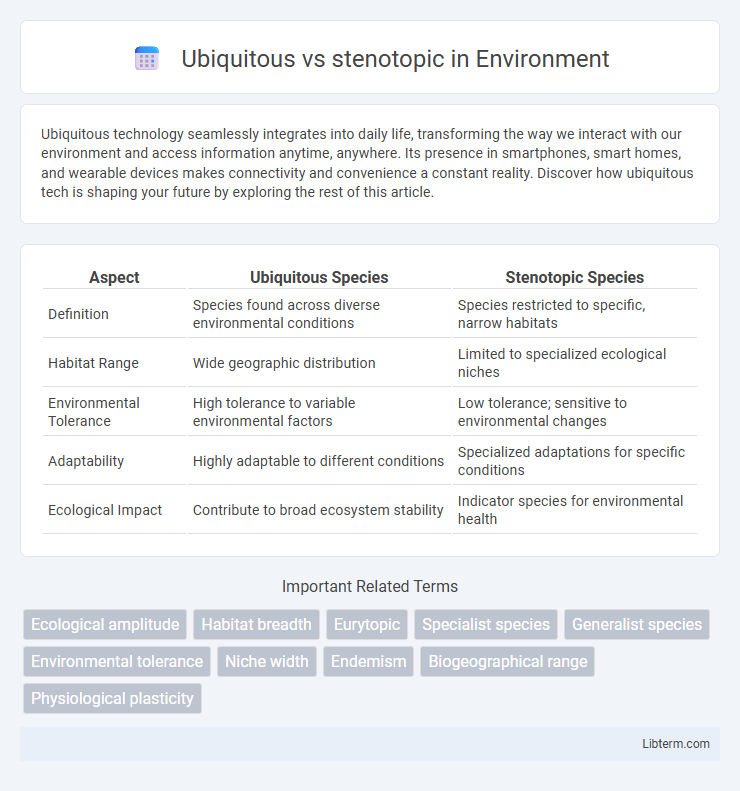Ubiquitous technology seamlessly integrates into daily life, transforming the way we interact with our environment and access information anytime, anywhere. Its presence in smartphones, smart homes, and wearable devices makes connectivity and convenience a constant reality. Discover how ubiquitous tech is shaping your future by exploring the rest of this article.
Table of Comparison
| Aspect | Ubiquitous Species | Stenotopic Species |
|---|---|---|
| Definition | Species found across diverse environmental conditions | Species restricted to specific, narrow habitats |
| Habitat Range | Wide geographic distribution | Limited to specialized ecological niches |
| Environmental Tolerance | High tolerance to variable environmental factors | Low tolerance; sensitive to environmental changes |
| Adaptability | Highly adaptable to different conditions | Specialized adaptations for specific conditions |
| Ecological Impact | Contribute to broad ecosystem stability | Indicator species for environmental health |
Understanding Ubiquitous and Stenotopic Organisms
Ubiquitous organisms thrive across diverse environments due to their broad ecological tolerance, often dominating ecosystems with adaptable traits. Stenotopic organisms exhibit narrow habitat specificity, surviving only within limited environmental conditions, which makes them sensitive indicators of ecosystem stability. Understanding the contrast between ubiquitous and stenotopic organisms is crucial for biodiversity assessment and habitat conservation strategies.
Defining Ubiquitous Species: Broad Ecological Presence
Ubiquitous species exhibit a broad ecological presence, thriving across diverse habitats and environmental conditions worldwide. Their adaptability to various climates, altitudes, and resource availability allows them to maintain stable populations in multiple ecosystems. This contrasts sharply with stenotopic species, which have narrow habitat requirements and limited ecological ranges due to specialized adaptations.
What Are Stenotopic Organisms? Narrow Habitat Specialization
Stenotopic organisms exhibit narrow habitat specialization, thriving exclusively in specific environmental conditions that limit their distribution range. These species are highly sensitive to ecological changes, often restricted to unique habitats such as certain soil types, microclimates, or specialized aquatic environments. In contrast, ubiquitous organisms display broad ecological tolerance, enabling them to inhabit diverse and widespread habitats globally.
Key Differences Between Ubiquitous and Stenotopic Species
Ubiquitous species exhibit broad ecological tolerance, thriving across diverse habitats and environmental conditions, while stenotopic species possess narrow ecological niches, restricting them to specific habitats with stable conditions. The key difference lies in their adaptability and range; ubiquitous species are generalists capable of surviving varying climates and resources, whereas stenotopic species are specialists highly sensitive to habitat changes. This distinction influences biodiversity patterns, ecosystem resilience, and conservation strategies due to their varying vulnerability to environmental disturbances.
Examples of Ubiquitous Species in Nature
Ubiquitous species, such as the common pigeon (Columba livia) and the house sparrow (Passer domesticus), thrive in diverse environments worldwide, from urban centers to rural areas. These species exhibit high ecological plasticity, allowing them to adapt to various habitats and climate conditions. In contrast, stenotopic species like the giant panda (Ailuropoda melanoleuca) have very narrow habitat requirements, often limited to specialized ecosystems such as bamboo forests.
Classic Stenotopic Organisms and Their Niches
Classic stenotopic organisms, such as the axolotl (Ambystoma mexicanum) and certain cichlid fish species, occupy highly specialized niches with narrow environmental tolerances. These organisms thrive in stable habitats like freshwater lakes with specific temperature, oxygen, and pH conditions, limiting their geographic distribution. Their narrow ecological amplitude contrasts with ubiquitous species, which adapt to a broad range of habitats and environmental variables.
Ecological Implications: Adaptability vs. Vulnerability
Ubiquitous species exhibit high ecological adaptability, thriving in diverse environments due to broad tolerance ranges for abiotic factors such as temperature, salinity, and habitat variability. In contrast, stenotopic species demonstrate vulnerability because of their narrow ecological niches and specialized habitat requirements, making them susceptible to environmental disturbances and habitat fragmentation. These differences influence ecosystem resilience, where ubiquitous species contribute to stability through functional redundancy, while stenotopic species are critical indicators of ecosystem health and biodiversity conservation priorities.
Environmental Changes and Species Distribution
Ubiquitous species exhibit broad tolerance to environmental changes, allowing them to inhabit diverse ecosystems and maintain widespread distribution. Stenotopic species display narrow environmental preferences, making them highly sensitive to habitat alterations and often confined to specific ecological niches. Environmental fluctuations significantly impact stenotopic species distribution, increasing their vulnerability to extinction compared to the resilient dispersal patterns of ubiquitous species.
Conservation Strategies for Ubiquitous and Stenotopic Species
Conservation strategies for ubiquitous species emphasize habitat connectivity and landscape-level management to support their broad ecological niches and wide distribution. For stenotopic species, characterized by narrow habitat requirements and limited ranges, conservation actions prioritize protecting and restoring specific microhabitats and mitigating localized threats. Effective conservation requires integrating species-specific ecological traits to balance ecosystem resilience and biodiversity preservation.
Future Perspectives: Studying Distribution Patterns in Changing Ecosystems
Future perspectives on studying distribution patterns in changing ecosystems emphasize the contrast between ubiquitous and stenotopic species, highlighting how widespread generalists adapt more flexibly to environmental shifts compared to narrow habitat specialists. Advances in remote sensing, environmental DNA (eDNA), and machine learning models enable finer resolution monitoring of species distribution, improving predictive accuracy under climate change scenarios. Integrating multi-scale data on habitat variability and species traits informs conservation strategies targeting vulnerable stenotopic species while leveraging the resilience of ubiquitous taxa.
Ubiquitous Infographic

 libterm.com
libterm.com